Niangua, MO Map & Demographics
Niangua Map
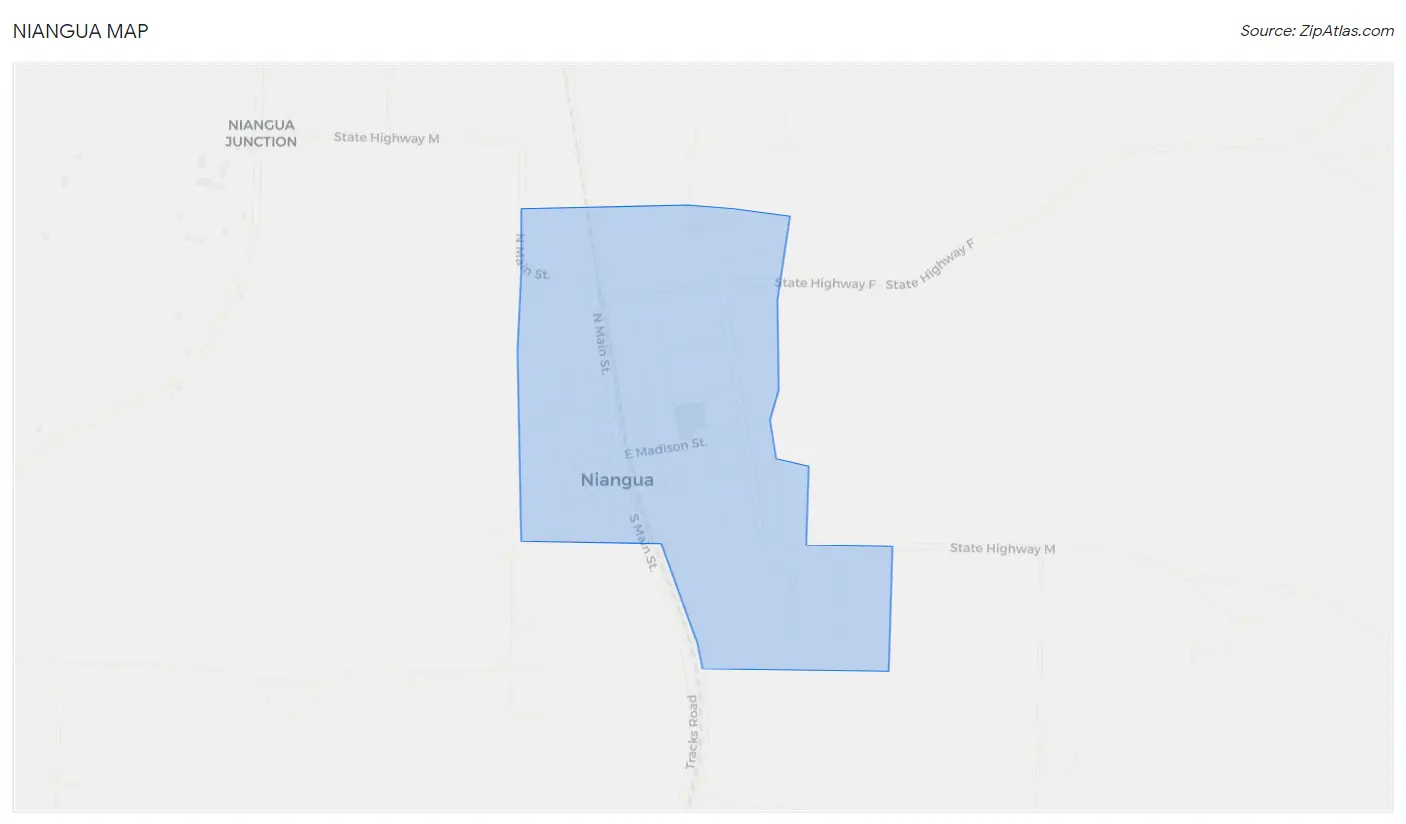
Niangua Overview
$15,384
PER CAPITA INCOME
$42,083
AVG FAMILY INCOME
$40,000
AVG HOUSEHOLD INCOME
35.2%
WAGE / INCOME GAP [ % ]
64.8¢/ $1
WAGE / INCOME GAP [ $ ]
0.35
INEQUALITY / GINI INDEX
548
TOTAL POPULATION
271
MALE POPULATION
277
FEMALE POPULATION
97.83
MALES / 100 FEMALES
102.21
FEMALES / 100 MALES
30.4
MEDIAN AGE
3.3
AVG FAMILY SIZE
2.7
AVG HOUSEHOLD SIZE
161
LABOR FORCE [ PEOPLE ]
42.9%
PERCENT IN LABOR FORCE
4.3%
UNEMPLOYMENT RATE
Niangua Zip Codes
Niangua Area Codes
Income in Niangua
Income Overview in Niangua
Per Capita Income in Niangua is $15,384, while median incomes of families and households are $42,083 and $40,000 respectively.
| Characteristic | Number | Measure |
| Per Capita Income | 548 | $15,384 |
| Median Family Income | 119 | $42,083 |
| Mean Family Income | 119 | $46,292 |
| Median Household Income | 202 | $40,000 |
| Mean Household Income | 202 | $42,892 |
| Income Deficit | 119 | $0 |
| Wage / Income Gap (%) | 548 | 35.19% |
| Wage / Income Gap ($) | 548 | 64.81¢ per $1 |
| Gini / Inequality Index | 548 | 0.35 |
Earnings by Sex in Niangua
Average Earnings in Niangua are $33,125, $40,500 for men and $26,250 for women, a difference of 35.2%.

| Sex | Number | Average Earnings |
| Male | 116 (63.7%) | $40,500 |
| Female | 66 (36.3%) | $26,250 |
| Total | 182 (100.0%) | $33,125 |
Earnings by Sex by Income Bracket in Niangua
The most common earnings brackets in Niangua are $40,000 to $44,999 for men (25 | 21.5%) and $35,000 to $39,999 for women (11 | 16.7%).
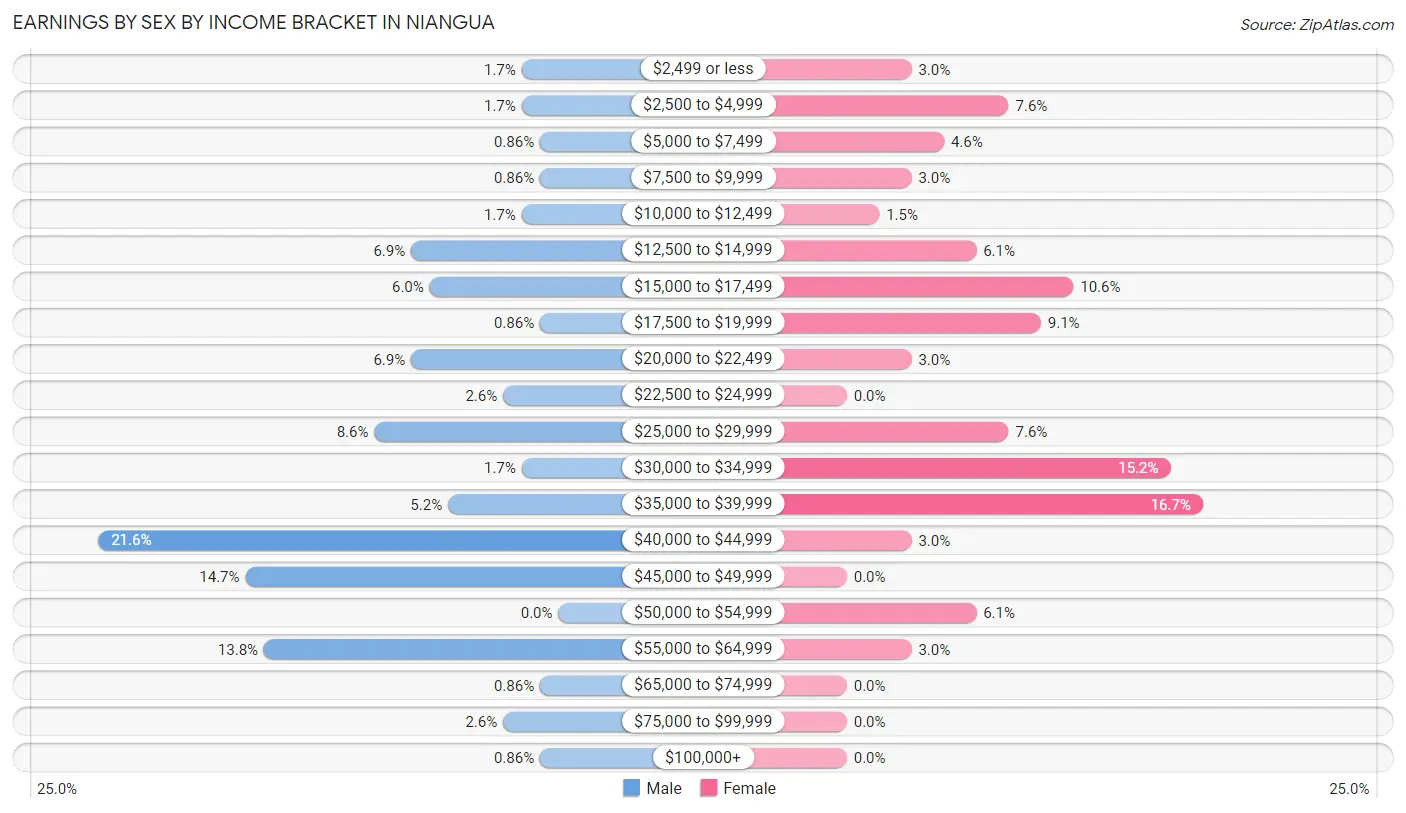
| Income | Male | Female |
| $2,499 or less | 2 (1.7%) | 2 (3.0%) |
| $2,500 to $4,999 | 2 (1.7%) | 5 (7.6%) |
| $5,000 to $7,499 | 1 (0.9%) | 3 (4.5%) |
| $7,500 to $9,999 | 1 (0.9%) | 2 (3.0%) |
| $10,000 to $12,499 | 2 (1.7%) | 1 (1.5%) |
| $12,500 to $14,999 | 8 (6.9%) | 4 (6.1%) |
| $15,000 to $17,499 | 7 (6.0%) | 7 (10.6%) |
| $17,500 to $19,999 | 1 (0.9%) | 6 (9.1%) |
| $20,000 to $22,499 | 8 (6.9%) | 2 (3.0%) |
| $22,500 to $24,999 | 3 (2.6%) | 0 (0.0%) |
| $25,000 to $29,999 | 10 (8.6%) | 5 (7.6%) |
| $30,000 to $34,999 | 2 (1.7%) | 10 (15.1%) |
| $35,000 to $39,999 | 6 (5.2%) | 11 (16.7%) |
| $40,000 to $44,999 | 25 (21.5%) | 2 (3.0%) |
| $45,000 to $49,999 | 17 (14.7%) | 0 (0.0%) |
| $50,000 to $54,999 | 0 (0.0%) | 4 (6.1%) |
| $55,000 to $64,999 | 16 (13.8%) | 2 (3.0%) |
| $65,000 to $74,999 | 1 (0.9%) | 0 (0.0%) |
| $75,000 to $99,999 | 3 (2.6%) | 0 (0.0%) |
| $100,000+ | 1 (0.9%) | 0 (0.0%) |
| Total | 116 (100.0%) | 66 (100.0%) |
Earnings by Sex by Educational Attainment in Niangua
Average earnings in Niangua are $40,650 for men and $27,917 for women, a difference of 31.3%. Men with an educational attainment of high school diploma enjoy the highest average annual earnings of $42,188, while those with less than high school education earn the least with $28,875. Women with an educational attainment of less than high school earn the most with the average annual earnings of $35,357, while those with college or associate's degree education have the smallest earnings of $31,250.

| Educational Attainment | Male Income | Female Income |
| Less than High School | $28,875 | $35,357 |
| High School Diploma | $42,188 | $0 |
| College or Associate's Degree | $40,882 | $31,250 |
| Bachelor's Degree | - | - |
| Graduate Degree | - | - |
| Total | $40,650 | $27,917 |
Family Income in Niangua
Family Income Brackets in Niangua
According to the Niangua family income data, there are 27 families falling into the $35,000 to $49,999 income range, which is the most common income bracket and makes up 22.7% of all families.

| Income Bracket | # Families | % Families |
| Less than $10,000 | 5 | 4.2% |
| $10,000 to $14,999 | 18 | 15.1% |
| $15,000 to $24,999 | 10 | 8.4% |
| $25,000 to $34,999 | 16 | 13.4% |
| $35,000 to $49,999 | 27 | 22.7% |
| $50,000 to $74,999 | 26 | 21.8% |
| $75,000 to $99,999 | 7 | 5.9% |
| $100,000 to $149,999 | 10 | 8.4% |
| $150,000 to $199,999 | 0 | 0.0% |
| $200,000+ | 0 | 0.0% |
Family Income by Famaliy Size in Niangua
3-person families (25 | 21.0%) account for the highest median family income in Niangua with $48,523 per family, while 2-person families (52 | 43.7%) have the highest median income of $16,562 per family member.

| Income Bracket | # Families | Median Income |
| 2-Person Families | 52 (43.7%) | $33,125 |
| 3-Person Families | 25 (21.0%) | $48,523 |
| 4-Person Families | 31 (26.1%) | $42,083 |
| 5-Person Families | 3 (2.5%) | $0 |
| 6-Person Families | 4 (3.4%) | $0 |
| 7+ Person Families | 4 (3.4%) | $0 |
| Total | 119 (100.0%) | $42,083 |
Family Income by Number of Earners in Niangua

| Number of Earners | # Families | Median Income |
| No Earners | 37 (31.1%) | $25,750 |
| 1 Earner | 54 (45.4%) | $41,667 |
| 2 Earners | 21 (17.6%) | $70,625 |
| 3+ Earners | 7 (5.9%) | $0 |
| Total | 119 (100.0%) | $42,083 |
Household Income in Niangua
Household Income Brackets in Niangua
With 56 households falling in the category, the $35,000 to $49,999 income range is the most frequent in Niangua, accounting for 27.7% of all households.

| Income Bracket | # Households | % Households |
| Less than $10,000 | 11 | 5.4% |
| $10,000 to $14,999 | 22 | 10.9% |
| $15,000 to $24,999 | 25 | 12.4% |
| $25,000 to $34,999 | 30 | 14.9% |
| $35,000 to $49,999 | 56 | 27.7% |
| $50,000 to $74,999 | 35 | 17.3% |
| $75,000 to $99,999 | 9 | 4.5% |
| $100,000 to $149,999 | 14 | 6.9% |
| $150,000 to $199,999 | 0 | 0.0% |
| $200,000+ | 0 | 0.0% |
Household Income by Householder Age in Niangua
The median household income in Niangua is $40,000, with the highest median household income of $41,042 found in the 25 to 44 years age bracket for the primary householder. A total of 70 households (34.6%) fall into this category. Meanwhile, the 15 to 24 years age bracket for the primary householder has the lowest median household income of $0, with 14 households (6.9%) in this group.

| Income Bracket | # Households | Median Income |
| 15 to 24 Years | 14 (6.9%) | $0 |
| 25 to 44 Years | 70 (34.6%) | $41,042 |
| 45 to 64 Years | 75 (37.1%) | $39,375 |
| 65+ Years | 43 (21.3%) | $39,464 |
| Total | 202 (100.0%) | $40,000 |
Poverty in Niangua
Income Below Poverty by Sex and Age in Niangua
With 20.0% poverty level for males and 40.4% for females among the residents of Niangua, 18 to 24 year old males and 12 to 14 year old females are the most vulnerable to poverty, with 15 males (71.4%) and 11 females (100.0%) in their respective age groups living below the poverty level.
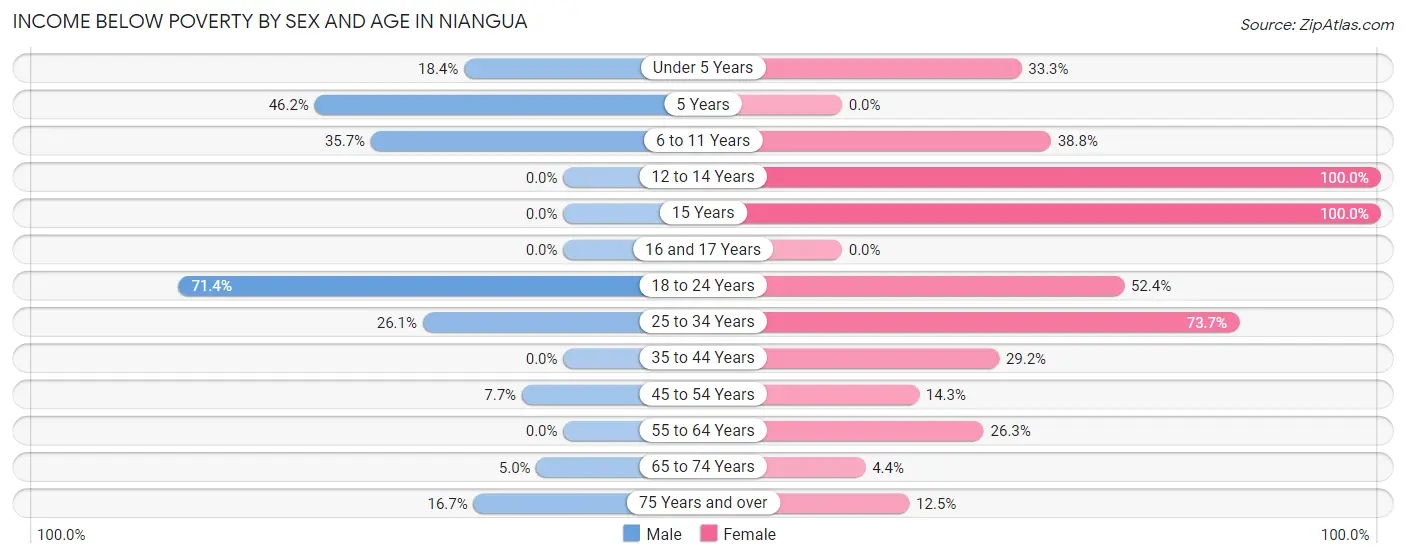
| Age Bracket | Male | Female |
| Under 5 Years | 7 (18.4%) | 9 (33.3%) |
| 5 Years | 6 (46.2%) | 0 (0.0%) |
| 6 to 11 Years | 10 (35.7%) | 19 (38.8%) |
| 12 to 14 Years | 0 (0.0%) | 11 (100.0%) |
| 15 Years | 0 (0.0%) | 2 (100.0%) |
| 16 and 17 Years | 0 (0.0%) | 0 (0.0%) |
| 18 to 24 Years | 15 (71.4%) | 11 (52.4%) |
| 25 to 34 Years | 12 (26.1%) | 42 (73.7%) |
| 35 to 44 Years | 0 (0.0%) | 7 (29.2%) |
| 45 to 54 Years | 1 (7.7%) | 3 (14.3%) |
| 55 to 64 Years | 0 (0.0%) | 5 (26.3%) |
| 65 to 74 Years | 1 (5.0%) | 1 (4.3%) |
| 75 Years and over | 2 (16.7%) | 2 (12.5%) |
| Total | 54 (20.0%) | 112 (40.4%) |
Income Above Poverty by Sex and Age in Niangua
According to the poverty statistics in Niangua, males aged 15 years and females aged 5 years are the age groups that are most secure financially, with 100.0% of males and 100.0% of females in these age groups living above the poverty line.
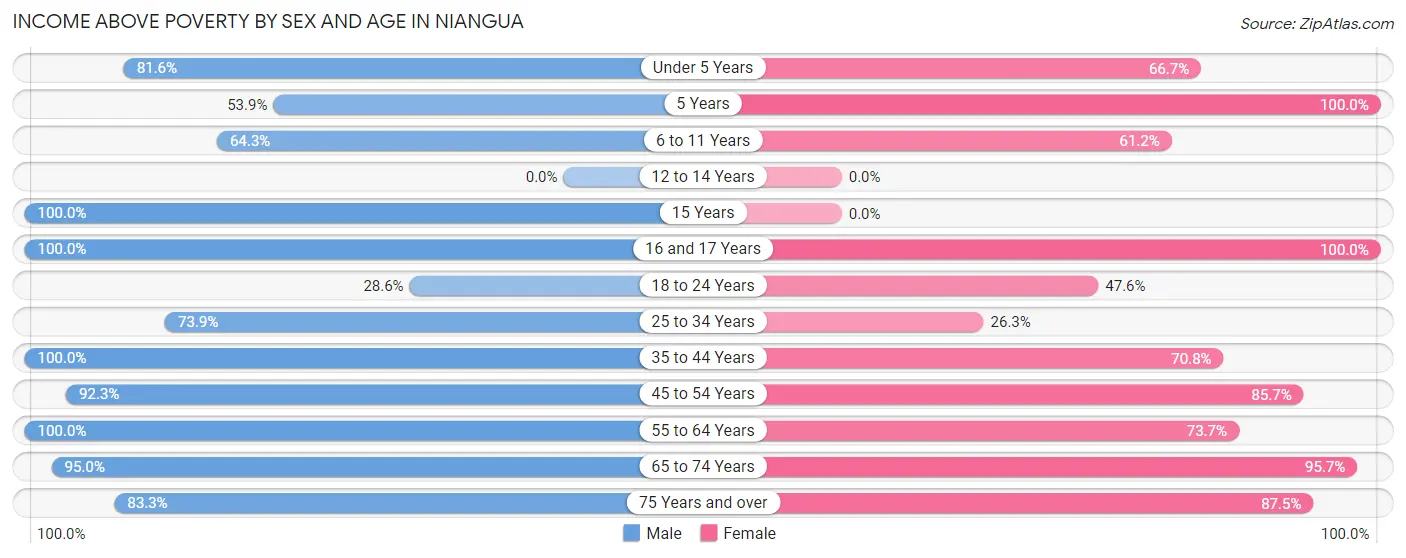
| Age Bracket | Male | Female |
| Under 5 Years | 31 (81.6%) | 18 (66.7%) |
| 5 Years | 7 (53.8%) | 3 (100.0%) |
| 6 to 11 Years | 18 (64.3%) | 30 (61.2%) |
| 12 to 14 Years | 0 (0.0%) | 0 (0.0%) |
| 15 Years | 1 (100.0%) | 0 (0.0%) |
| 16 and 17 Years | 7 (100.0%) | 4 (100.0%) |
| 18 to 24 Years | 6 (28.6%) | 10 (47.6%) |
| 25 to 34 Years | 34 (73.9%) | 15 (26.3%) |
| 35 to 44 Years | 16 (100.0%) | 17 (70.8%) |
| 45 to 54 Years | 12 (92.3%) | 18 (85.7%) |
| 55 to 64 Years | 55 (100.0%) | 14 (73.7%) |
| 65 to 74 Years | 19 (95.0%) | 22 (95.7%) |
| 75 Years and over | 10 (83.3%) | 14 (87.5%) |
| Total | 216 (80.0%) | 165 (59.6%) |
Income Below Poverty Among Married-Couple Families in Niangua
The poverty statistics for married-couple families in Niangua show that 25.0% or 19 of the total 76 families live below the poverty line. Families with 5 or more children have the highest poverty rate of 100.0%, comprising of 4 families. On the other hand, families with 3 or 4 children have the lowest poverty rate of 0.0%, which includes 0 families.

| Children | Above Poverty | Below Poverty |
| No Children | 37 (74.0%) | 13 (26.0%) |
| 1 or 2 Children | 17 (89.5%) | 2 (10.5%) |
| 3 or 4 Children | 3 (100.0%) | 0 (0.0%) |
| 5 or more Children | 0 (0.0%) | 4 (100.0%) |
| Total | 57 (75.0%) | 19 (25.0%) |
Income Below Poverty Among Single-Parent Households in Niangua
According to the poverty data in Niangua, 22.2% or 6 single-father households and 25.0% or 4 single-mother households are living below the poverty line. Among single-father households, those with 3 or 4 children have the highest poverty rate, with 6 households (75.0%) experiencing poverty. Likewise, among single-mother households, those with 1 or 2 children have the highest poverty rate, with 4 households (50.0%) falling below the poverty line.

| Children | Single Father | Single Mother |
| No Children | 0 (0.0%) | 0 (0.0%) |
| 1 or 2 Children | 0 (0.0%) | 4 (50.0%) |
| 3 or 4 Children | 6 (75.0%) | 0 (0.0%) |
| 5 or more Children | 0 (0.0%) | 0 (0.0%) |
| Total | 6 (22.2%) | 4 (25.0%) |
Income Below Poverty Among Married-Couple vs Single-Parent Households in Niangua
The poverty data for Niangua shows that 19 of the married-couple family households (25.0%) and 10 of the single-parent households (23.3%) are living below the poverty level. Within the married-couple family households, those with 5 or more children have the highest poverty rate, with 4 households (100.0%) falling below the poverty line. Among the single-parent households, those with 3 or 4 children have the highest poverty rate, with 6 household (50.0%) living below poverty.

| Children | Married-Couple Families | Single-Parent Households |
| No Children | 13 (26.0%) | 0 (0.0%) |
| 1 or 2 Children | 2 (10.5%) | 4 (16.0%) |
| 3 or 4 Children | 0 (0.0%) | 6 (50.0%) |
| 5 or more Children | 4 (100.0%) | 0 (0.0%) |
| Total | 19 (25.0%) | 10 (23.3%) |
Race in Niangua
The most populous races in Niangua are White / Caucasian (523 | 95.4%), Hispanic or Latino (31 | 5.7%), and Two or more Races (22 | 4.0%).

| Race | # Population | % Population |
| Asian | 0 | 0.0% |
| Black / African American | 0 | 0.0% |
| Hawaiian / Pacific | 0 | 0.0% |
| Hispanic or Latino | 31 | 5.7% |
| Native / Alaskan | 3 | 0.5% |
| White / Caucasian | 523 | 95.4% |
| Two or more Races | 22 | 4.0% |
| Some other Race | 0 | 0.0% |
| Total | 548 | 100.0% |
Ancestry in Niangua
The most populous ancestries reported in Niangua are German (87 | 15.9%), Irish (58 | 10.6%), American (51 | 9.3%), Central American (17 | 3.1%), and Salvadoran (17 | 3.1%), together accounting for 42.0% of all Niangua residents.
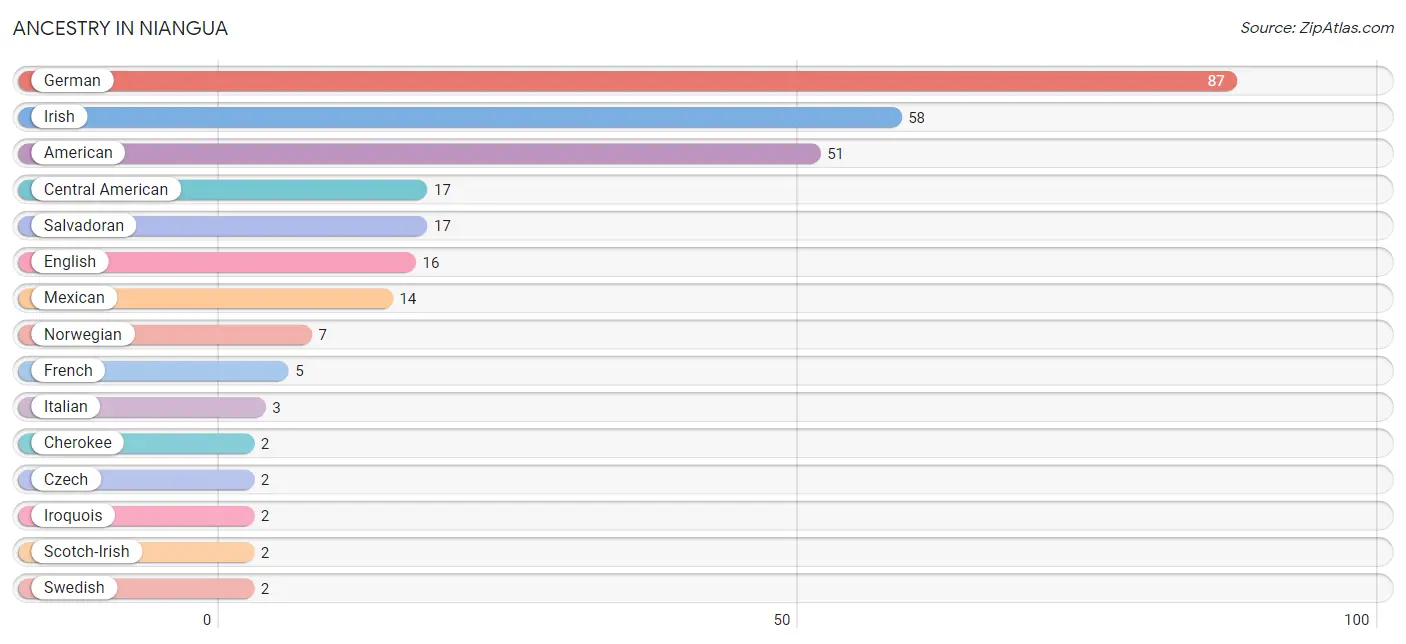
| Ancestry | # Population | % Population |
| American | 51 | 9.3% |
| Austrian | 1 | 0.2% |
| Central American | 17 | 3.1% |
| Cherokee | 2 | 0.4% |
| Czech | 2 | 0.4% |
| Dutch | 1 | 0.2% |
| English | 16 | 2.9% |
| French | 5 | 0.9% |
| German | 87 | 15.9% |
| Irish | 58 | 10.6% |
| Iroquois | 2 | 0.4% |
| Italian | 3 | 0.5% |
| Mexican | 14 | 2.5% |
| Norwegian | 7 | 1.3% |
| Salvadoran | 17 | 3.1% |
| Scotch-Irish | 2 | 0.4% |
| Scottish | 1 | 0.2% |
| Swedish | 2 | 0.4% |
| Welsh | 2 | 0.4% | View All 19 Rows |
Immigrants in Niangua

| Immigration Origin | # Population | % Population | View All 0 Rows |
Sex and Age in Niangua
Sex and Age in Niangua
The most populous age groups in Niangua are 5 to 9 Years (42 | 15.5%) for men and 30 to 34 Years (46 | 16.6%) for women.
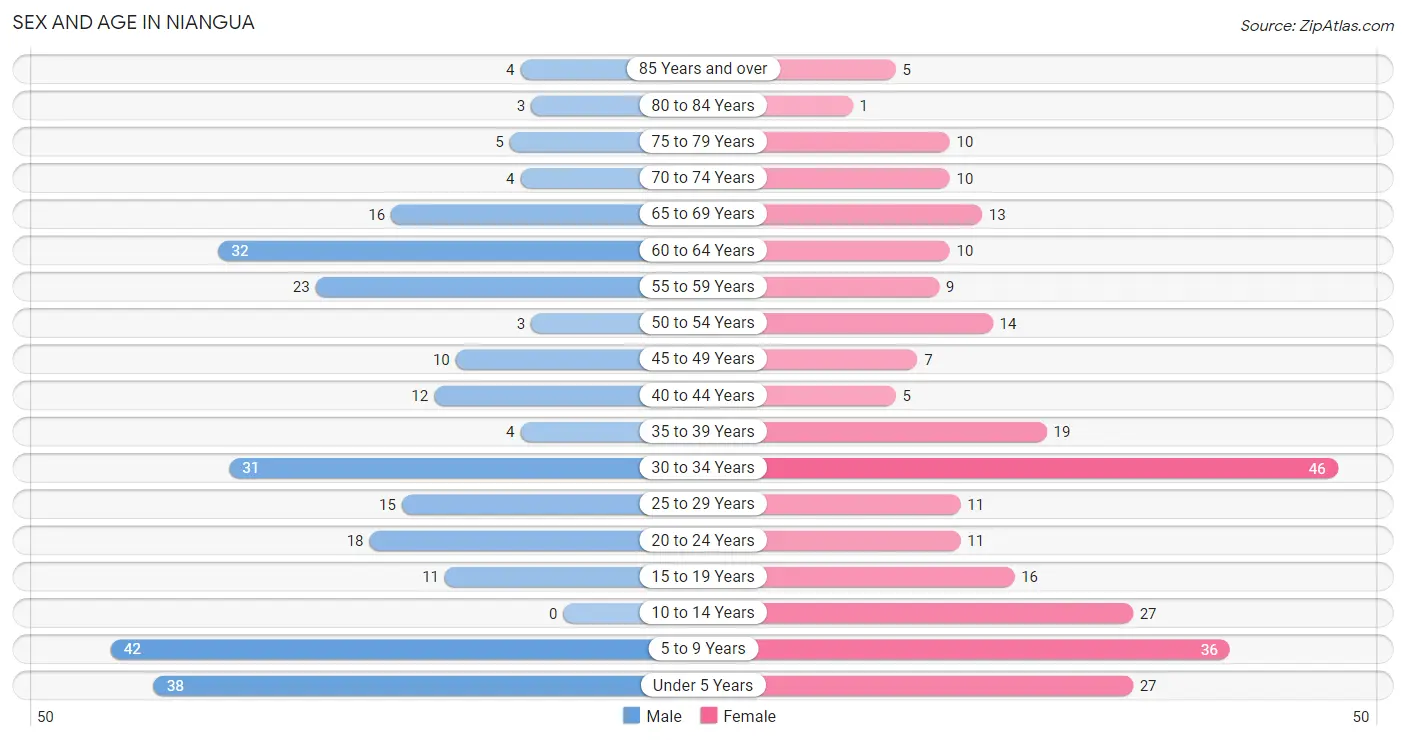
| Age Bracket | Male | Female |
| Under 5 Years | 38 (14.0%) | 27 (9.8%) |
| 5 to 9 Years | 42 (15.5%) | 36 (13.0%) |
| 10 to 14 Years | 0 (0.0%) | 27 (9.8%) |
| 15 to 19 Years | 11 (4.1%) | 16 (5.8%) |
| 20 to 24 Years | 18 (6.6%) | 11 (4.0%) |
| 25 to 29 Years | 15 (5.5%) | 11 (4.0%) |
| 30 to 34 Years | 31 (11.4%) | 46 (16.6%) |
| 35 to 39 Years | 4 (1.5%) | 19 (6.9%) |
| 40 to 44 Years | 12 (4.4%) | 5 (1.8%) |
| 45 to 49 Years | 10 (3.7%) | 7 (2.5%) |
| 50 to 54 Years | 3 (1.1%) | 14 (5.1%) |
| 55 to 59 Years | 23 (8.5%) | 9 (3.3%) |
| 60 to 64 Years | 32 (11.8%) | 10 (3.6%) |
| 65 to 69 Years | 16 (5.9%) | 13 (4.7%) |
| 70 to 74 Years | 4 (1.5%) | 10 (3.6%) |
| 75 to 79 Years | 5 (1.8%) | 10 (3.6%) |
| 80 to 84 Years | 3 (1.1%) | 1 (0.4%) |
| 85 Years and over | 4 (1.5%) | 5 (1.8%) |
| Total | 271 (100.0%) | 277 (100.0%) |
Families and Households in Niangua
Median Family Size in Niangua
The median family size in Niangua is 3.33 persons per family, with single male/father families (27 | 22.7%) accounting for the largest median family size of 4.19 persons per family. On the other hand, married-couple families (76 | 63.9%) represent the smallest median family size with 3.04 persons per family.

| Family Type | # Families | Family Size |
| Married-Couple | 76 (63.9%) | 3.04 |
| Single Male/Father | 27 (22.7%) | 4.19 |
| Single Female/Mother | 16 (13.5%) | 3.25 |
| Total Families | 119 (100.0%) | 3.33 |
Median Household Size in Niangua
The median household size in Niangua is 2.71 persons per household, with single male/father households (27 | 13.4%) accounting for the largest median household size of 5.78 persons per household. non-family households (83 | 41.1%) represent the smallest median household size with 1.24 persons per household.

| Household Type | # Households | Household Size |
| Married-Couple | 76 (37.6%) | 3.04 |
| Single Male/Father | 27 (13.4%) | 5.78 |
| Single Female/Mother | 16 (7.9%) | 3.63 |
| Non-family | 83 (41.1%) | 1.24 |
| Total Households | 202 (100.0%) | 2.71 |
Household Size by Marriage Status in Niangua
Out of a total of 202 households in Niangua, 119 (58.9%) are family households, while 83 (41.1%) are nonfamily households. The most numerous type of family households are 2-person households, comprising 49, and the most common type of nonfamily households are 1-person households, comprising 61.

| Household Size | Family Households | Nonfamily Households |
| 1-Person Households | - | 61 (30.2%) |
| 2-Person Households | 49 (24.3%) | 22 (10.9%) |
| 3-Person Households | 15 (7.4%) | 0 (0.0%) |
| 4-Person Households | 32 (15.8%) | 0 (0.0%) |
| 5-Person Households | 15 (7.4%) | 0 (0.0%) |
| 6-Person Households | 4 (2.0%) | 0 (0.0%) |
| 7+ Person Households | 4 (2.0%) | 0 (0.0%) |
| Total | 119 (58.9%) | 83 (41.1%) |
Female Fertility in Niangua
Fertility by Age in Niangua
Average fertility rate in Niangua is 34.0 births per 1,000 women. Women in the age bracket of 20 to 34 years have the highest fertility rate with 59.0 births per 1,000 women. Women in the age bracket of 20 to 34 years acount for 100.0% of all women with births.

| Age Bracket | Women with Births | Births / 1,000 Women |
| 15 to 19 years | 0 (0.0%) | 0.0 |
| 20 to 34 years | 4 (100.0%) | 59.0 |
| 35 to 50 years | 0 (0.0%) | 0.0 |
| Total | 4 (100.0%) | 34.0 |
Fertility by Age by Marriage Status in Niangua

| Age Bracket | Married | Unmarried |
| 15 to 19 years | 0 (0.0%) | 0 (0.0%) |
| 20 to 34 years | 4 (100.0%) | 0 (0.0%) |
| 35 to 50 years | 0 (0.0%) | 0 (0.0%) |
| Total | 4 (100.0%) | 0 (0.0%) |
Fertility by Education in Niangua
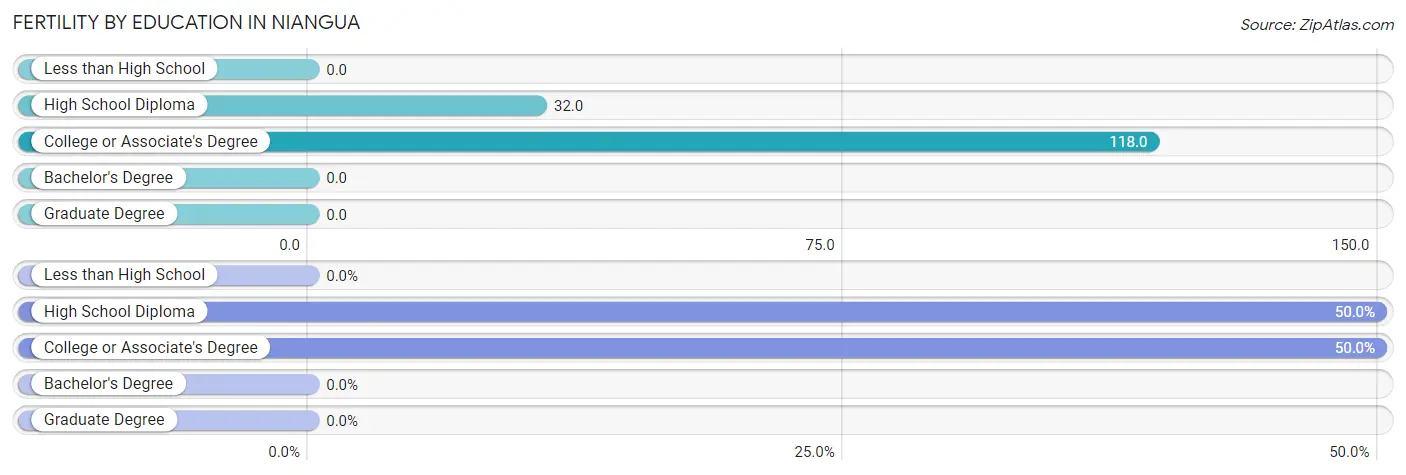
| Educational Attainment | Women with Births | Births / 1,000 Women |
| Less than High School | 0 (0.0%) | 0.0 |
| High School Diploma | 2 (50.0%) | 32.0 |
| College or Associate's Degree | 2 (50.0%) | 118.0 |
| Bachelor's Degree | 0 (0.0%) | 0.0 |
| Graduate Degree | 0 (0.0%) | 0.0 |
| Total | 4 (100.0%) | 34.0 |
Fertility by Education by Marriage Status in Niangua

| Educational Attainment | Married | Unmarried |
| Less than High School | 0 (0.0%) | 0 (0.0%) |
| High School Diploma | 2 (100.0%) | 0 (0.0%) |
| College or Associate's Degree | 2 (100.0%) | 0 (0.0%) |
| Bachelor's Degree | 0 (0.0%) | 0 (0.0%) |
| Graduate Degree | 0 (0.0%) | 0 (0.0%) |
| Total | 4 (100.0%) | 0 (0.0%) |
Employment Characteristics in Niangua
Employment by Class of Employer in Niangua
Among the 154 employed individuals in Niangua, private company employees (120 | 77.9%), local government employees (11 | 7.1%), and not-for-profit organizations (9 | 5.8%) make up the most common classes of employment.

| Employer Class | # Employees | % Employees |
| Private Company Employees | 120 | 77.9% |
| Self-Employed (Incorporated) | 2 | 1.3% |
| Self-Employed (Not Incorporated) | 7 | 4.5% |
| Not-for-profit Organizations | 9 | 5.8% |
| Local Government Employees | 11 | 7.1% |
| State Government Employees | 4 | 2.6% |
| Federal Government Employees | 1 | 0.6% |
| Unpaid Family Workers | 0 | 0.0% |
| Total | 154 | 100.0% |
Employment Status by Age in Niangua
According to the labor force statistics for Niangua, out of the total population over 16 years of age (375), 42.9% or 161 individuals are in the labor force, with 4.3% or 7 of them unemployed. The age group with the highest labor force participation rate is 45 to 54 years, with 94.1% or 32 individuals in the labor force. Within the labor force, the 65 to 74 years age range has the highest percentage of unemployed individuals, with 20.0% or 1 of them being unemployed.

| Age Bracket | In Labor Force | Unemployed |
| 16 to 19 Years | 0 (0.0%) | 0 (0.0%) |
| 20 to 24 Years | 10 (34.5%) | 0 (0.0%) |
| 25 to 29 Years | 15 (57.7%) | 0 (0.0%) |
| 30 to 34 Years | 34 (44.2%) | 0 (0.0%) |
| 35 to 44 Years | 36 (90.0%) | 0 (0.0%) |
| 45 to 54 Years | 32 (94.1%) | 6 (18.8%) |
| 55 to 59 Years | 22 (68.8%) | 0 (0.0%) |
| 60 to 64 Years | 6 (14.3%) | 0 (0.0%) |
| 65 to 74 Years | 5 (11.6%) | 1 (20.0%) |
| 75 Years and over | 1 (3.6%) | 0 (0.0%) |
| Total | 161 (42.9%) | 7 (4.3%) |
Employment Status by Educational Attainment in Niangua
According to labor force statistics for Niangua, 57.8% of individuals (145) out of the total population between 25 and 64 years of age (251) are in the labor force, with 4.1% or 6 of them being unemployed. The group with the highest labor force participation rate are those with the educational attainment of bachelor's degree or higher, with 100.0% or 6 individuals in the labor force. Within the labor force, individuals with high school diploma education have the highest percentage of unemployment, with 10.9% or 6 of them being unemployed.

| Educational Attainment | In Labor Force | Unemployed |
| Less than High School | 35 (79.5%) | 0 (0.0%) |
| High School Diploma | 55 (41.4%) | 14 (10.9%) |
| College / Associate Degree | 49 (72.1%) | 0 (0.0%) |
| Bachelor's Degree or higher | 6 (100.0%) | 0 (0.0%) |
| Total | 145 (57.8%) | 10 (4.1%) |
Employment Occupations by Sex in Niangua
Management, Business, Science and Arts Occupations
The most common Management, Business, Science and Arts occupations in Niangua are Management (9 | 5.8%), Business & Financial (8 | 5.2%), Community & Social Service (2 | 1.3%), Arts, Media & Entertainment (2 | 1.3%), and Health Diagnosing & Treating (2 | 1.3%).
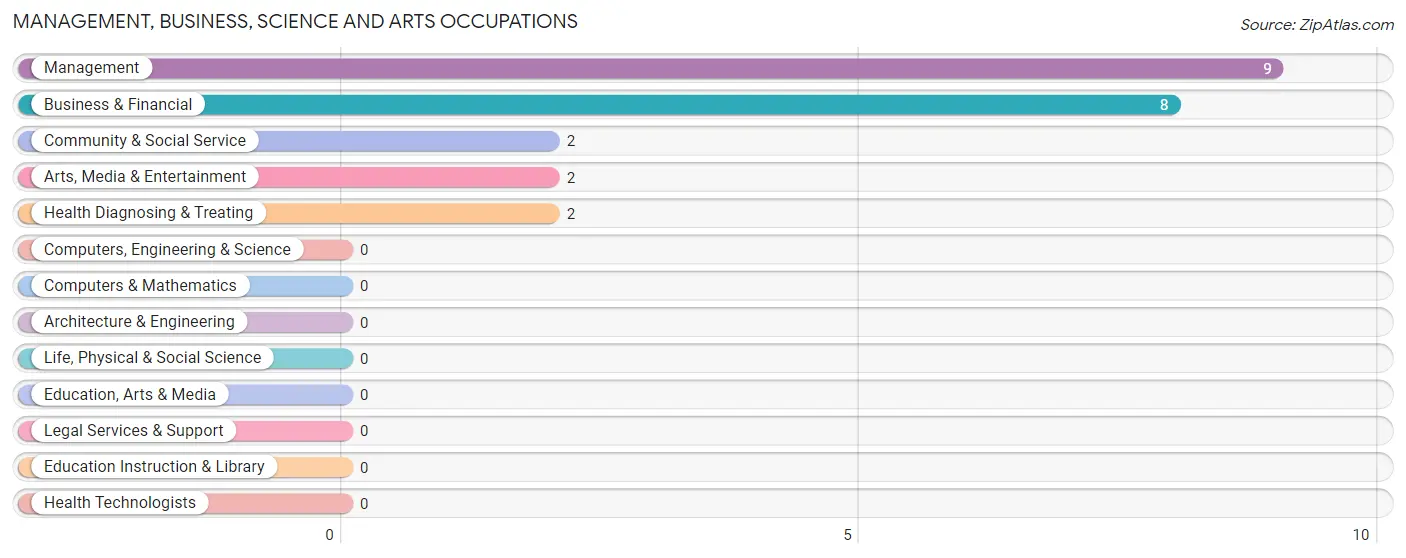
Management, Business, Science and Arts Occupations by Sex
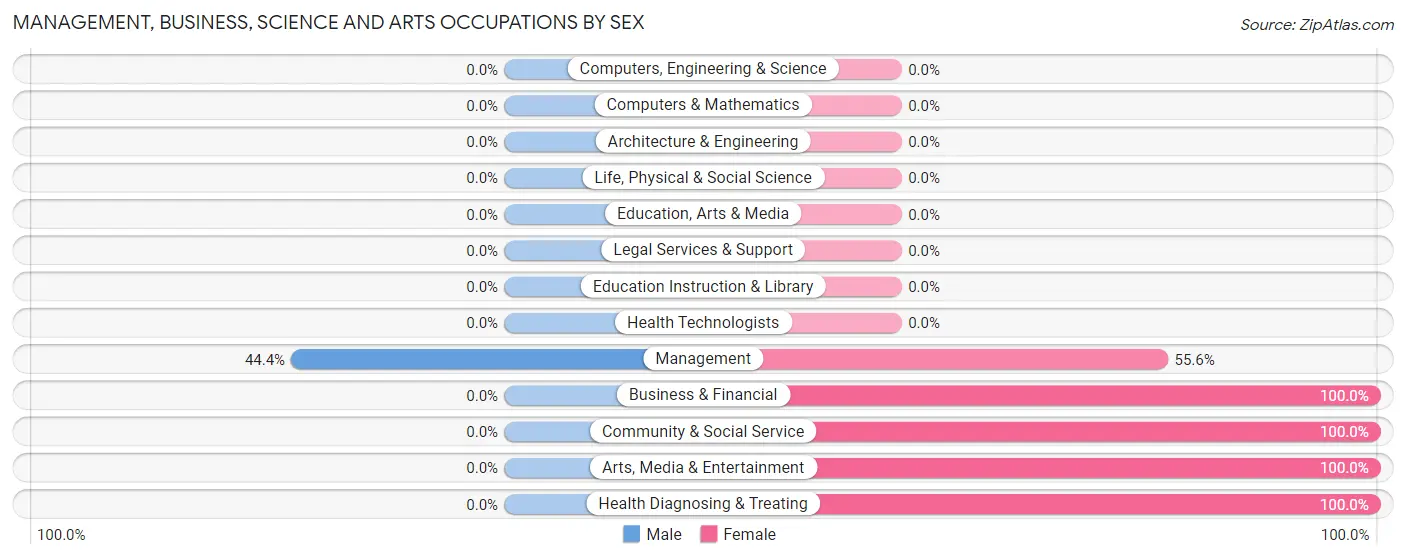
| Occupation | Male | Female |
| Management | 4 (44.4%) | 5 (55.6%) |
| Business & Financial | 0 (0.0%) | 8 (100.0%) |
| Computers, Engineering & Science | 0 (0.0%) | 0 (0.0%) |
| Computers & Mathematics | 0 (0.0%) | 0 (0.0%) |
| Architecture & Engineering | 0 (0.0%) | 0 (0.0%) |
| Life, Physical & Social Science | 0 (0.0%) | 0 (0.0%) |
| Community & Social Service | 0 (0.0%) | 2 (100.0%) |
| Education, Arts & Media | 0 (0.0%) | 0 (0.0%) |
| Legal Services & Support | 0 (0.0%) | 0 (0.0%) |
| Education Instruction & Library | 0 (0.0%) | 0 (0.0%) |
| Arts, Media & Entertainment | 0 (0.0%) | 2 (100.0%) |
| Health Diagnosing & Treating | 0 (0.0%) | 2 (100.0%) |
| Health Technologists | 0 (0.0%) | 0 (0.0%) |
| Total (Category) | 4 (19.1%) | 17 (80.9%) |
| Total (Overall) | 99 (64.3%) | 55 (35.7%) |
Services Occupations
The most common Services occupations in Niangua are Food Preparation & Serving (27 | 17.5%), Healthcare Support (15 | 9.7%), Cleaning & Maintenance (8 | 5.2%), and Personal Care & Service (2 | 1.3%).

Services Occupations by Sex
Within the Services occupations in Niangua, the most male-oriented occupations are Food Preparation & Serving (66.7%), Cleaning & Maintenance (37.5%), and Healthcare Support (20.0%), while the most female-oriented occupations are Personal Care & Service (100.0%), Healthcare Support (80.0%), and Cleaning & Maintenance (62.5%).

| Occupation | Male | Female |
| Healthcare Support | 3 (20.0%) | 12 (80.0%) |
| Security & Protection | 0 (0.0%) | 0 (0.0%) |
| Firefighting & Prevention | 0 (0.0%) | 0 (0.0%) |
| Law Enforcement | 0 (0.0%) | 0 (0.0%) |
| Food Preparation & Serving | 18 (66.7%) | 9 (33.3%) |
| Cleaning & Maintenance | 3 (37.5%) | 5 (62.5%) |
| Personal Care & Service | 0 (0.0%) | 2 (100.0%) |
| Total (Category) | 24 (46.2%) | 28 (53.8%) |
| Total (Overall) | 99 (64.3%) | 55 (35.7%) |
Sales and Office Occupations
The most common Sales and Office occupations in Niangua are Sales & Related (12 | 7.8%), and Office & Administration (1 | 0.6%).

Sales and Office Occupations by Sex

| Occupation | Male | Female |
| Sales & Related | 6 (50.0%) | 6 (50.0%) |
| Office & Administration | 0 (0.0%) | 1 (100.0%) |
| Total (Category) | 6 (46.2%) | 7 (53.8%) |
| Total (Overall) | 99 (64.3%) | 55 (35.7%) |
Natural Resources, Construction and Maintenance Occupations
The most common Natural Resources, Construction and Maintenance occupations in Niangua are Construction & Extraction (29 | 18.8%), and Installation, Maintenance & Repair (4 | 2.6%).

Natural Resources, Construction and Maintenance Occupations by Sex

| Occupation | Male | Female |
| Farming, Fishing & Forestry | 0 (0.0%) | 0 (0.0%) |
| Construction & Extraction | 29 (100.0%) | 0 (0.0%) |
| Installation, Maintenance & Repair | 4 (100.0%) | 0 (0.0%) |
| Total (Category) | 33 (100.0%) | 0 (0.0%) |
| Total (Overall) | 99 (64.3%) | 55 (35.7%) |
Production, Transportation and Moving Occupations
The most common Production, Transportation and Moving occupations in Niangua are Production (27 | 17.5%), Transportation (5 | 3.3%), and Material Moving (3 | 1.9%).

Production, Transportation and Moving Occupations by Sex

| Occupation | Male | Female |
| Production | 24 (88.9%) | 3 (11.1%) |
| Transportation | 5 (100.0%) | 0 (0.0%) |
| Material Moving | 3 (100.0%) | 0 (0.0%) |
| Total (Category) | 32 (91.4%) | 3 (8.6%) |
| Total (Overall) | 99 (64.3%) | 55 (35.7%) |
Employment Industries by Sex in Niangua
Employment Industries in Niangua
The major employment industries in Niangua include Construction (33 | 21.4%), Retail Trade (31 | 20.1%), Health Care & Social Assistance (24 | 15.6%), Accommodation & Food Services (22 | 14.3%), and Manufacturing (17 | 11.0%).
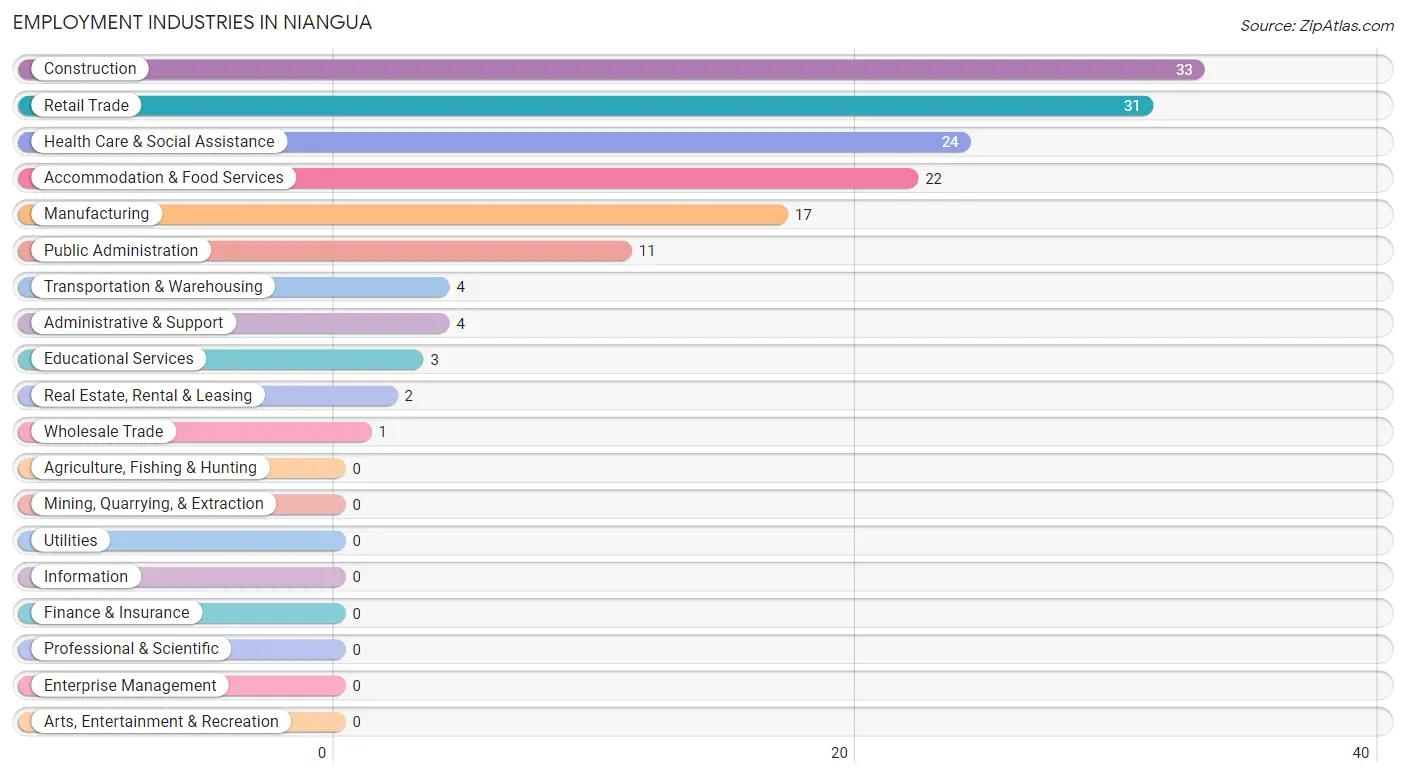
Employment Industries by Sex in Niangua
The Niangua industries that see more men than women are Construction (100.0%), Wholesale Trade (100.0%), and Transportation & Warehousing (100.0%), whereas the industries that tend to have a higher number of women are Educational Services (100.0%), Health Care & Social Assistance (87.5%), and Retail Trade (61.3%).
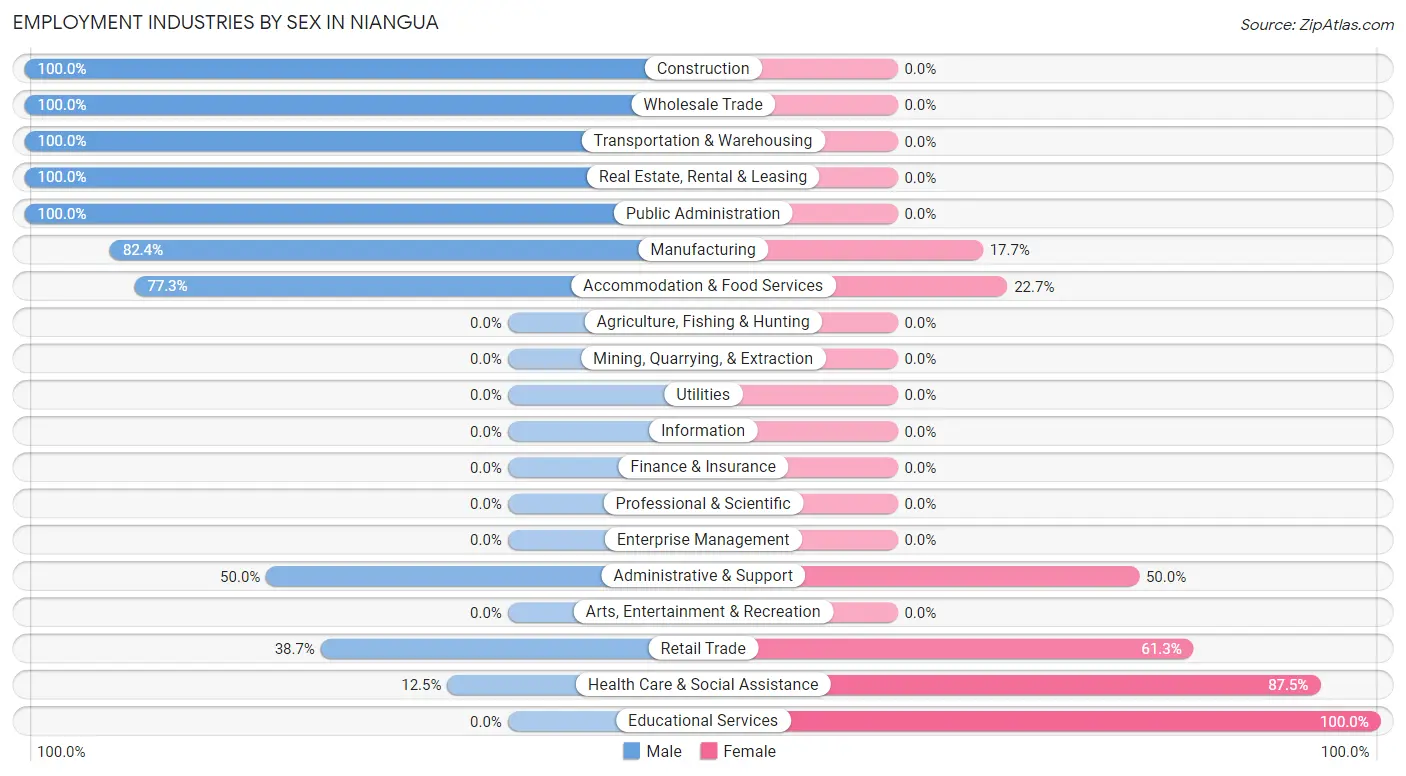
| Industry | Male | Female |
| Agriculture, Fishing & Hunting | 0 (0.0%) | 0 (0.0%) |
| Mining, Quarrying, & Extraction | 0 (0.0%) | 0 (0.0%) |
| Construction | 33 (100.0%) | 0 (0.0%) |
| Manufacturing | 14 (82.4%) | 3 (17.6%) |
| Wholesale Trade | 1 (100.0%) | 0 (0.0%) |
| Retail Trade | 12 (38.7%) | 19 (61.3%) |
| Transportation & Warehousing | 4 (100.0%) | 0 (0.0%) |
| Utilities | 0 (0.0%) | 0 (0.0%) |
| Information | 0 (0.0%) | 0 (0.0%) |
| Finance & Insurance | 0 (0.0%) | 0 (0.0%) |
| Real Estate, Rental & Leasing | 2 (100.0%) | 0 (0.0%) |
| Professional & Scientific | 0 (0.0%) | 0 (0.0%) |
| Enterprise Management | 0 (0.0%) | 0 (0.0%) |
| Administrative & Support | 2 (50.0%) | 2 (50.0%) |
| Educational Services | 0 (0.0%) | 3 (100.0%) |
| Health Care & Social Assistance | 3 (12.5%) | 21 (87.5%) |
| Arts, Entertainment & Recreation | 0 (0.0%) | 0 (0.0%) |
| Accommodation & Food Services | 17 (77.3%) | 5 (22.7%) |
| Public Administration | 11 (100.0%) | 0 (0.0%) |
| Total | 99 (64.3%) | 55 (35.7%) |
Education in Niangua
School Enrollment in Niangua
The most common levels of schooling among the 156 students in Niangua are elementary school (42 | 26.9%), nursery / preschool (28 | 17.9%), and middle school (27 | 17.3%).

| School Level | # Students | % Students |
| Nursery / Preschool | 28 | 17.9% |
| Kindergarten | 23 | 14.7% |
| Elementary School | 42 | 26.9% |
| Middle School | 27 | 17.3% |
| High School | 14 | 9.0% |
| College / Undergraduate | 22 | 14.1% |
| Graduate / Professional | 0 | 0.0% |
| Total | 156 | 100.0% |
School Enrollment by Age by Funding Source in Niangua
Out of a total of 156 students who are enrolled in schools in Niangua, 9 (5.8%) attend a private institution, while the remaining 147 (94.2%) are enrolled in public schools. The age group of 3 to 4 year olds has the highest likelihood of being enrolled in private schools, with 3 (13.6% in the age bracket) enrolled. Conversely, the age group of 15 to 17 year olds has the lowest likelihood of being enrolled in a private school, with 14 (100.0% in the age bracket) attending a public institution.

| Age Bracket | Public School | Private School |
| 3 to 4 Year Olds | 19 (86.4%) | 3 (13.6%) |
| 5 to 9 Year Old | 66 (93.0%) | 5 (7.0%) |
| 10 to 14 Year Olds | 26 (96.3%) | 1 (3.7%) |
| 15 to 17 Year Olds | 14 (100.0%) | 0 (0.0%) |
| 18 to 19 Year Olds | 0 (0.0%) | 0 (0.0%) |
| 20 to 24 Year Olds | 1 (100.0%) | 0 (0.0%) |
| 25 to 34 Year Olds | 17 (100.0%) | 0 (0.0%) |
| 35 Years and over | 4 (100.0%) | 0 (0.0%) |
| Total | 147 (94.2%) | 9 (5.8%) |
Educational Attainment by Field of Study in Niangua
Physical & health sciences (3 | 30.0%), business (3 | 30.0%), education (3 | 30.0%), and psychology (1 | 10.0%) are the most common fields of study among 10 individuals in Niangua who have obtained a bachelor's degree or higher.
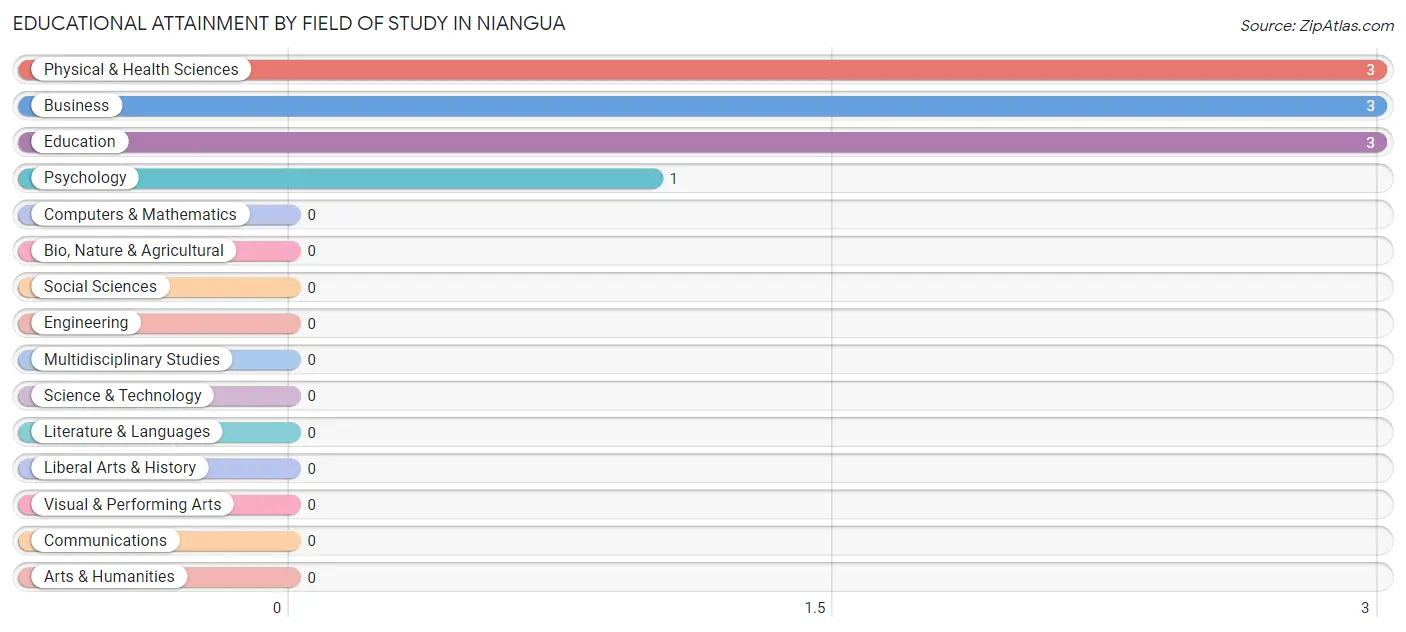
| Field of Study | # Graduates | % Graduates |
| Computers & Mathematics | 0 | 0.0% |
| Bio, Nature & Agricultural | 0 | 0.0% |
| Physical & Health Sciences | 3 | 30.0% |
| Psychology | 1 | 10.0% |
| Social Sciences | 0 | 0.0% |
| Engineering | 0 | 0.0% |
| Multidisciplinary Studies | 0 | 0.0% |
| Science & Technology | 0 | 0.0% |
| Business | 3 | 30.0% |
| Education | 3 | 30.0% |
| Literature & Languages | 0 | 0.0% |
| Liberal Arts & History | 0 | 0.0% |
| Visual & Performing Arts | 0 | 0.0% |
| Communications | 0 | 0.0% |
| Arts & Humanities | 0 | 0.0% |
| Total | 10 | 100.0% |
Transportation & Commute in Niangua
Vehicle Availability by Sex in Niangua
The most prevalent vehicle ownership categories in Niangua are males with 1 vehicle (41, accounting for 41.4%) and females with 1 vehicle (11, making up 74.6%).

| Vehicles Available | Male | Female |
| No Vehicle | 13 (13.1%) | 7 (12.7%) |
| 1 Vehicle | 41 (41.4%) | 11 (20.0%) |
| 2 Vehicles | 29 (29.3%) | 24 (43.6%) |
| 3 Vehicles | 7 (7.1%) | 6 (10.9%) |
| 4 Vehicles | 4 (4.0%) | 0 (0.0%) |
| 5 or more Vehicles | 5 (5.1%) | 7 (12.7%) |
| Total | 99 (100.0%) | 55 (100.0%) |
Commute Time in Niangua
The most frequently occuring commute durations in Niangua are 45 to 59 minutes (30 commuters, 19.9%), 30 to 34 minutes (28 commuters, 18.5%), and 15 to 19 minutes (21 commuters, 13.9%).
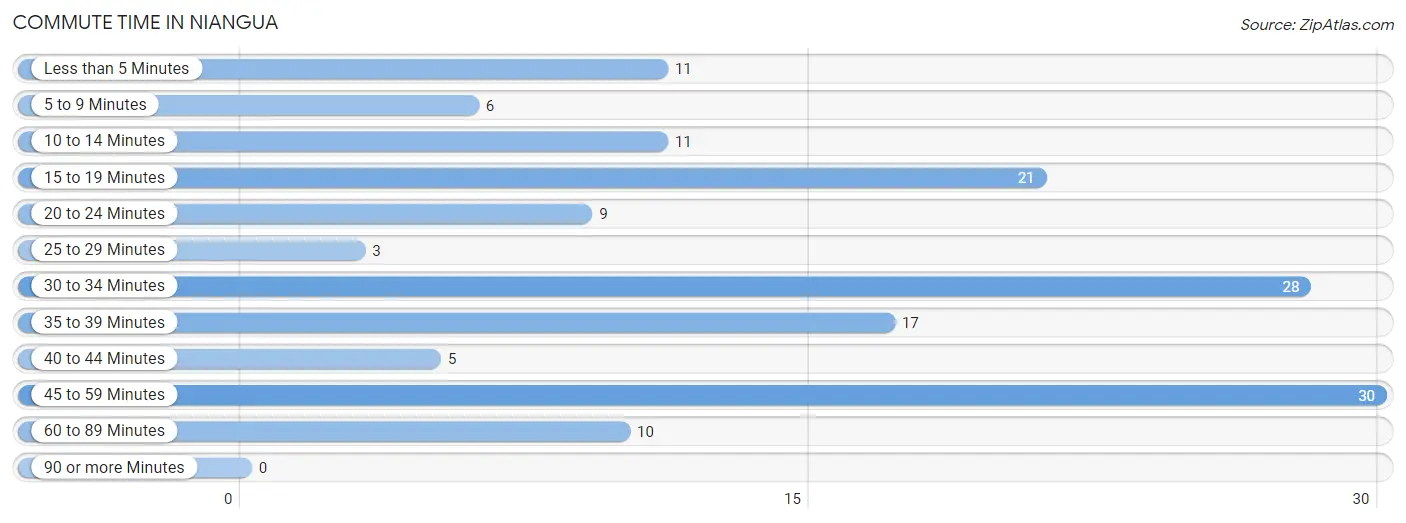
| Commute Time | # Commuters | % Commuters |
| Less than 5 Minutes | 11 | 7.3% |
| 5 to 9 Minutes | 6 | 4.0% |
| 10 to 14 Minutes | 11 | 7.3% |
| 15 to 19 Minutes | 21 | 13.9% |
| 20 to 24 Minutes | 9 | 6.0% |
| 25 to 29 Minutes | 3 | 2.0% |
| 30 to 34 Minutes | 28 | 18.5% |
| 35 to 39 Minutes | 17 | 11.3% |
| 40 to 44 Minutes | 5 | 3.3% |
| 45 to 59 Minutes | 30 | 19.9% |
| 60 to 89 Minutes | 10 | 6.6% |
| 90 or more Minutes | 0 | 0.0% |
Commute Time by Sex in Niangua
The most common commute times in Niangua are 45 to 59 minutes (23 commuters, 23.5%) for males and 30 to 34 minutes (14 commuters, 26.4%) for females.
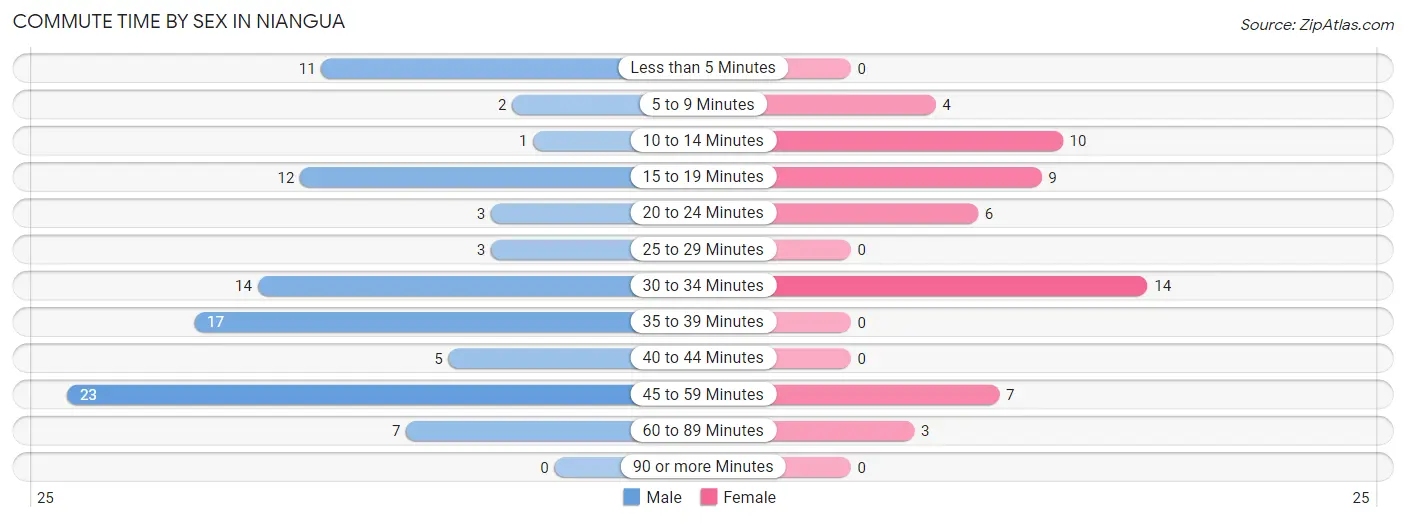
| Commute Time | Male | Female |
| Less than 5 Minutes | 11 (11.2%) | 0 (0.0%) |
| 5 to 9 Minutes | 2 (2.0%) | 4 (7.5%) |
| 10 to 14 Minutes | 1 (1.0%) | 10 (18.9%) |
| 15 to 19 Minutes | 12 (12.2%) | 9 (17.0%) |
| 20 to 24 Minutes | 3 (3.1%) | 6 (11.3%) |
| 25 to 29 Minutes | 3 (3.1%) | 0 (0.0%) |
| 30 to 34 Minutes | 14 (14.3%) | 14 (26.4%) |
| 35 to 39 Minutes | 17 (17.3%) | 0 (0.0%) |
| 40 to 44 Minutes | 5 (5.1%) | 0 (0.0%) |
| 45 to 59 Minutes | 23 (23.5%) | 7 (13.2%) |
| 60 to 89 Minutes | 7 (7.1%) | 3 (5.7%) |
| 90 or more Minutes | 0 (0.0%) | 0 (0.0%) |
Time of Departure to Work by Sex in Niangua
The most frequent times of departure to work in Niangua are 12:00 PM to 3:59 PM (23, 23.5%) for males and 12:00 AM to 4:59 AM (13, 24.5%) for females.
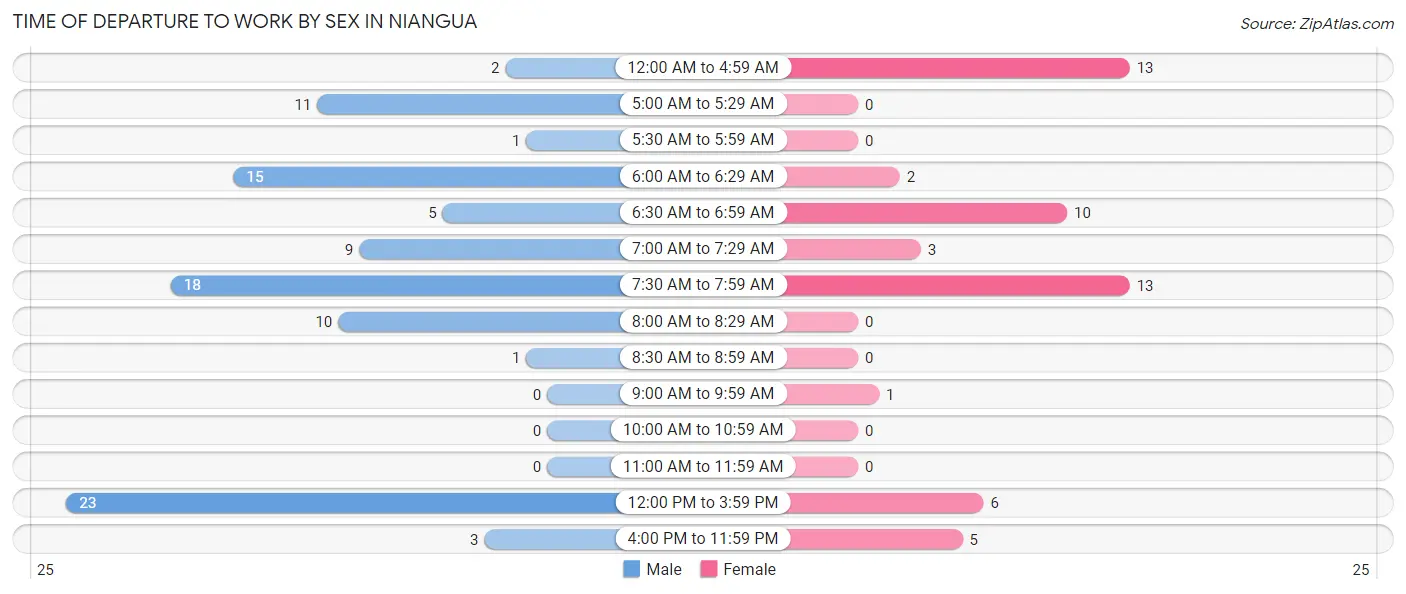
| Time of Departure | Male | Female |
| 12:00 AM to 4:59 AM | 2 (2.0%) | 13 (24.5%) |
| 5:00 AM to 5:29 AM | 11 (11.2%) | 0 (0.0%) |
| 5:30 AM to 5:59 AM | 1 (1.0%) | 0 (0.0%) |
| 6:00 AM to 6:29 AM | 15 (15.3%) | 2 (3.8%) |
| 6:30 AM to 6:59 AM | 5 (5.1%) | 10 (18.9%) |
| 7:00 AM to 7:29 AM | 9 (9.2%) | 3 (5.7%) |
| 7:30 AM to 7:59 AM | 18 (18.4%) | 13 (24.5%) |
| 8:00 AM to 8:29 AM | 10 (10.2%) | 0 (0.0%) |
| 8:30 AM to 8:59 AM | 1 (1.0%) | 0 (0.0%) |
| 9:00 AM to 9:59 AM | 0 (0.0%) | 1 (1.9%) |
| 10:00 AM to 10:59 AM | 0 (0.0%) | 0 (0.0%) |
| 11:00 AM to 11:59 AM | 0 (0.0%) | 0 (0.0%) |
| 12:00 PM to 3:59 PM | 23 (23.5%) | 6 (11.3%) |
| 4:00 PM to 11:59 PM | 3 (3.1%) | 5 (9.4%) |
| Total | 98 (100.0%) | 53 (100.0%) |
Housing Occupancy in Niangua
Occupancy by Ownership in Niangua
Of the total 202 dwellings in Niangua, owner-occupied units account for 102 (50.5%), while renter-occupied units make up 100 (49.5%).

| Occupancy | # Housing Units | % Housing Units |
| Owner Occupied Housing Units | 102 | 50.5% |
| Renter-Occupied Housing Units | 100 | 49.5% |
| Total Occupied Housing Units | 202 | 100.0% |
Occupancy by Household Size in Niangua

| Household Size | # Housing Units | % Housing Units |
| 1-Person Household | 61 | 30.2% |
| 2-Person Household | 71 | 35.1% |
| 3-Person Household | 15 | 7.4% |
| 4+ Person Household | 55 | 27.2% |
| Total Housing Units | 202 | 100.0% |
Occupancy by Ownership by Household Size in Niangua

| Household Size | Owner-occupied | Renter-occupied |
| 1-Person Household | 26 (42.6%) | 35 (57.4%) |
| 2-Person Household | 48 (67.6%) | 23 (32.4%) |
| 3-Person Household | 9 (60.0%) | 6 (40.0%) |
| 4+ Person Household | 19 (34.5%) | 36 (65.4%) |
| Total Housing Units | 102 (50.5%) | 100 (49.5%) |
Occupancy by Educational Attainment in Niangua

| Household Size | Owner-occupied | Renter-occupied |
| Less than High School | 10 (35.7%) | 18 (64.3%) |
| High School Diploma | 47 (45.2%) | 57 (54.8%) |
| College/Associate Degree | 41 (65.1%) | 22 (34.9%) |
| Bachelor's Degree or higher | 4 (57.1%) | 3 (42.9%) |
Occupancy by Age of Householder in Niangua

| Age Bracket | # Households | % Households |
| Under 35 Years | 62 | 30.7% |
| 35 to 44 Years | 22 | 10.9% |
| 45 to 54 Years | 25 | 12.4% |
| 55 to 64 Years | 50 | 24.7% |
| 65 to 74 Years | 24 | 11.9% |
| 75 to 84 Years | 12 | 5.9% |
| 85 Years and Over | 7 | 3.5% |
| Total | 202 | 100.0% |
Housing Finances in Niangua
Median Income by Occupancy in Niangua

| Occupancy Type | # Households | Median Income |
| Owner-Occupied | 102 (50.5%) | $37,692 |
| Renter-Occupied | 100 (49.5%) | $41,250 |
| Average | 202 (100.0%) | $40,000 |
Occupancy by Householder Income Bracket in Niangua
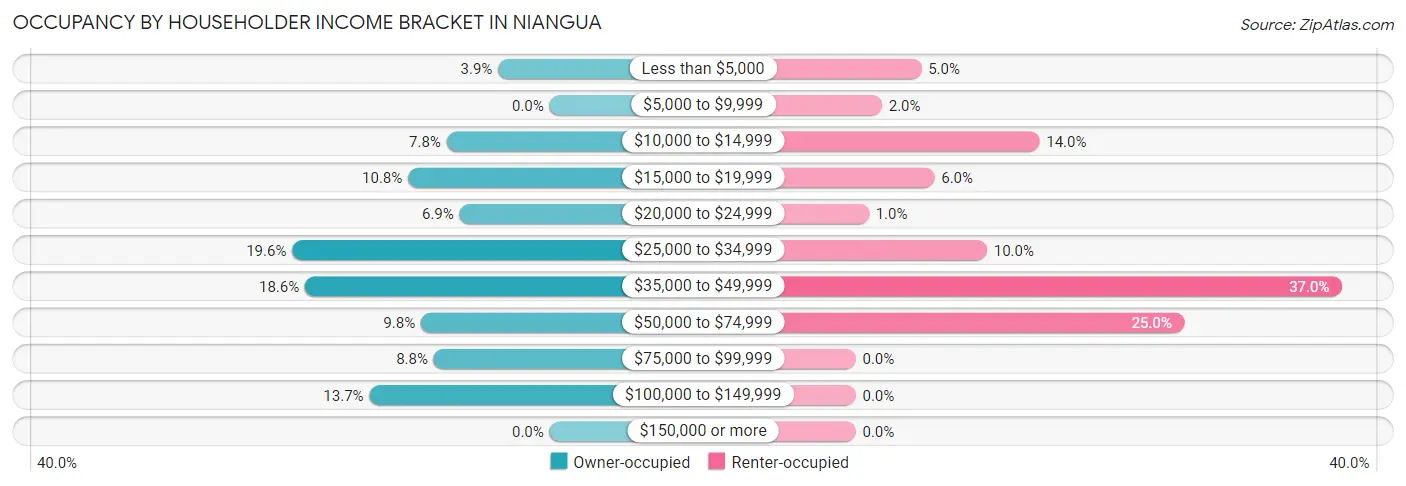
| Income Bracket | Owner-occupied | Renter-occupied |
| Less than $5,000 | 4 (3.9%) | 5 (5.0%) |
| $5,000 to $9,999 | 0 (0.0%) | 2 (2.0%) |
| $10,000 to $14,999 | 8 (7.8%) | 14 (14.0%) |
| $15,000 to $19,999 | 11 (10.8%) | 6 (6.0%) |
| $20,000 to $24,999 | 7 (6.9%) | 1 (1.0%) |
| $25,000 to $34,999 | 20 (19.6%) | 10 (10.0%) |
| $35,000 to $49,999 | 19 (18.6%) | 37 (37.0%) |
| $50,000 to $74,999 | 10 (9.8%) | 25 (25.0%) |
| $75,000 to $99,999 | 9 (8.8%) | 0 (0.0%) |
| $100,000 to $149,999 | 14 (13.7%) | 0 (0.0%) |
| $150,000 or more | 0 (0.0%) | 0 (0.0%) |
| Total | 102 (100.0%) | 100 (100.0%) |
Monthly Housing Cost Tiers in Niangua

| Monthly Cost | Owner-occupied | Renter-occupied |
| Less than $300 | 26 (25.5%) | 3 (3.0%) |
| $300 to $499 | 25 (24.5%) | 12 (12.0%) |
| $500 to $799 | 19 (18.6%) | 47 (47.0%) |
| $800 to $999 | 11 (10.8%) | 20 (20.0%) |
| $1,000 to $1,499 | 16 (15.7%) | 13 (13.0%) |
| $1,500 to $1,999 | 5 (4.9%) | 0 (0.0%) |
| $2,000 to $2,499 | 0 (0.0%) | 0 (0.0%) |
| $2,500 to $2,999 | 0 (0.0%) | 0 (0.0%) |
| $3,000 or more | 0 (0.0%) | 0 (0.0%) |
| Total | 102 (100.0%) | 100 (100.0%) |
Physical Housing Characteristics in Niangua
Housing Structures in Niangua

| Structure Type | # Housing Units | % Housing Units |
| Single Unit, Detached | 124 | 61.4% |
| Single Unit, Attached | 1 | 0.5% |
| 2 Unit Apartments | 14 | 6.9% |
| 3 or 4 Unit Apartments | 4 | 2.0% |
| 5 to 9 Unit Apartments | 0 | 0.0% |
| 10 or more Apartments | 17 | 8.4% |
| Mobile Home / Other | 42 | 20.8% |
| Total | 202 | 100.0% |
Housing Structures by Occupancy in Niangua

| Structure Type | Owner-occupied | Renter-occupied |
| Single Unit, Detached | 88 (71.0%) | 36 (29.0%) |
| Single Unit, Attached | 1 (100.0%) | 0 (0.0%) |
| 2 Unit Apartments | 0 (0.0%) | 14 (100.0%) |
| 3 or 4 Unit Apartments | 0 (0.0%) | 4 (100.0%) |
| 5 to 9 Unit Apartments | 0 (0.0%) | 0 (0.0%) |
| 10 or more Apartments | 0 (0.0%) | 17 (100.0%) |
| Mobile Home / Other | 13 (30.9%) | 29 (69.1%) |
| Total | 102 (50.5%) | 100 (49.5%) |
Housing Structures by Number of Rooms in Niangua

| Number of Rooms | Owner-occupied | Renter-occupied |
| 1 Room | 0 (0.0%) | 0 (0.0%) |
| 2 or 3 Rooms | 1 (1.0%) | 24 (24.0%) |
| 4 or 5 Rooms | 45 (44.1%) | 64 (64.0%) |
| 6 or 7 Rooms | 31 (30.4%) | 12 (12.0%) |
| 8 or more Rooms | 25 (24.5%) | 0 (0.0%) |
| Total | 102 (100.0%) | 100 (100.0%) |
Housing Structure by Heating Type in Niangua

| Heating Type | Owner-occupied | Renter-occupied |
| Utility Gas | 5 (4.9%) | 0 (0.0%) |
| Bottled, Tank, or LP Gas | 45 (44.1%) | 31 (31.0%) |
| Electricity | 39 (38.2%) | 68 (68.0%) |
| Fuel Oil or Kerosene | 0 (0.0%) | 0 (0.0%) |
| Coal or Coke | 0 (0.0%) | 0 (0.0%) |
| All other Fuels | 11 (10.8%) | 1 (1.0%) |
| No Fuel Used | 2 (2.0%) | 0 (0.0%) |
| Total | 102 (100.0%) | 100 (100.0%) |
Household Vehicle Usage in Niangua

| Vehicles per Household | Owner-occupied | Renter-occupied |
| No Vehicle | 10 (9.8%) | 27 (27.0%) |
| 1 Vehicle | 38 (37.2%) | 49 (49.0%) |
| 2 Vehicles | 36 (35.3%) | 15 (15.0%) |
| 3 or more Vehicles | 18 (17.6%) | 9 (9.0%) |
| Total | 102 (100.0%) | 100 (100.0%) |
Real Estate & Mortgages in Niangua
Real Estate and Mortgage Overview in Niangua
| Characteristic | Without Mortgage | With Mortgage |
| Housing Units | 57 | 45 |
| Median Property Value | $67,500 | $96,300 |
| Median Household Income | $26,563 | $0 |
| Monthly Housing Costs | $318 | $0 |
| Real Estate Taxes | $475 | $1 |
Property Value by Mortgage Status in Niangua

| Property Value | Without Mortgage | With Mortgage |
| Less than $50,000 | 26 (45.6%) | 3 (6.7%) |
| $50,000 to $99,999 | 13 (22.8%) | 24 (53.3%) |
| $100,000 to $299,999 | 18 (31.6%) | 18 (40.0%) |
| $300,000 to $499,999 | 0 (0.0%) | 0 (0.0%) |
| $500,000 to $749,999 | 0 (0.0%) | 0 (0.0%) |
| $750,000 to $999,999 | 0 (0.0%) | 0 (0.0%) |
| $1,000,000 or more | 0 (0.0%) | 0 (0.0%) |
| Total | 57 (100.0%) | 45 (100.0%) |
Household Income by Mortgage Status in Niangua

| Household Income | Without Mortgage | With Mortgage |
| Less than $10,000 | 1 (1.8%) | 0 (0.0%) |
| $10,000 to $24,999 | 25 (43.9%) | 3 (6.7%) |
| $25,000 to $34,999 | 13 (22.8%) | 1 (2.2%) |
| $35,000 to $49,999 | 13 (22.8%) | 7 (15.6%) |
| $50,000 to $74,999 | 2 (3.5%) | 6 (13.3%) |
| $75,000 to $99,999 | 0 (0.0%) | 8 (17.8%) |
| $100,000 to $149,999 | 3 (5.3%) | 9 (20.0%) |
| $150,000 or more | 0 (0.0%) | 11 (24.4%) |
| Total | 57 (100.0%) | 45 (100.0%) |
Property Value to Household Income Ratio in Niangua

| Value-to-Income Ratio | Without Mortgage | With Mortgage |
| Less than 2.0x | 24 (42.1%) | 65,417 (145,371.1%) |
| 2.0x to 2.9x | 8 (14.0%) | 26 (57.8%) |
| 3.0x to 3.9x | 8 (14.0%) | 13 (28.9%) |
| 4.0x or more | 17 (29.8%) | 2 (4.4%) |
| Total | 57 (100.0%) | 45 (100.0%) |
Real Estate Taxes by Mortgage Status in Niangua

| Property Taxes | Without Mortgage | With Mortgage |
| Less than $800 | 51 (89.5%) | 0 (0.0%) |
| $800 to $1,499 | 3 (5.3%) | 30 (66.7%) |
| $800 to $1,499 | 2 (3.5%) | 14 (31.1%) |
| Total | 57 (100.0%) | 45 (100.0%) |
Health & Disability in Niangua
Health Insurance Coverage by Age in Niangua

| Age Bracket | With Coverage | Without Coverage |
| Under 6 Years | 79 (97.5%) | 2 (2.5%) |
| 6 to 18 Years | 106 (100.0%) | 0 (0.0%) |
| 19 to 25 Years | 36 (76.6%) | 11 (23.4%) |
| 26 to 34 Years | 65 (68.4%) | 30 (31.6%) |
| 35 to 44 Years | 31 (77.5%) | 9 (22.5%) |
| 45 to 54 Years | 22 (64.7%) | 12 (35.3%) |
| 55 to 64 Years | 53 (71.6%) | 21 (28.4%) |
| 65 to 74 Years | 43 (100.0%) | 0 (0.0%) |
| 75 Years and older | 28 (100.0%) | 0 (0.0%) |
| Total | 463 (84.5%) | 85 (15.5%) |
Health Insurance Coverage by Citizenship Status in Niangua

| Citizenship Status | With Coverage | Without Coverage |
| Native Born | 79 (97.5%) | 2 (2.5%) |
| Foreign Born, Citizen | 106 (100.0%) | 0 (0.0%) |
| Foreign Born, not a Citizen | 36 (76.6%) | 11 (23.4%) |
Health Insurance Coverage by Household Income in Niangua

| Household Income | With Coverage | Without Coverage |
| Under $25,000 | 115 (95.8%) | 5 (4.2%) |
| $25,000 to $49,999 | 194 (79.5%) | 50 (20.5%) |
| $50,000 to $74,999 | 102 (85.0%) | 18 (15.0%) |
| $75,000 to $99,999 | 25 (100.0%) | 0 (0.0%) |
| $100,000 and over | 27 (69.2%) | 12 (30.8%) |
Public vs Private Health Insurance Coverage by Age in Niangua

| Age Bracket | Public Insurance | Private Insurance |
| Under 6 | 68 (84.0%) | 11 (13.6%) |
| 6 to 18 Years | 85 (80.2%) | 21 (19.8%) |
| 19 to 25 Years | 30 (63.8%) | 6 (12.8%) |
| 25 to 34 Years | 50 (52.6%) | 15 (15.8%) |
| 35 to 44 Years | 17 (42.5%) | 14 (35.0%) |
| 45 to 54 Years | 9 (26.5%) | 13 (38.2%) |
| 55 to 64 Years | 47 (63.5%) | 14 (18.9%) |
| 65 to 74 Years | 43 (100.0%) | 11 (25.6%) |
| 75 Years and over | 28 (100.0%) | 14 (50.0%) |
| Total | 377 (68.8%) | 119 (21.7%) |
Disability Status by Sex by Age in Niangua

| Age Bracket | Male | Female |
| Under 5 Years | 0 (0.0%) | 0 (0.0%) |
| 5 to 17 Years | 14 (28.0%) | 0 (0.0%) |
| 18 to 34 Years | 17 (25.4%) | 9 (11.5%) |
| 35 to 64 Years | 28 (33.3%) | 13 (20.3%) |
| 65 to 74 Years | 13 (65.0%) | 9 (39.1%) |
| 75 Years and over | 5 (41.7%) | 10 (62.5%) |
Disability Class by Sex by Age in Niangua
Disability Class: Hearing Difficulty

| Age Bracket | Male | Female |
| Under 5 Years | 0 (0.0%) | 0 (0.0%) |
| 5 to 17 Years | 0 (0.0%) | 0 (0.0%) |
| 18 to 34 Years | 0 (0.0%) | 0 (0.0%) |
| 35 to 64 Years | 11 (13.1%) | 0 (0.0%) |
| 65 to 74 Years | 8 (40.0%) | 0 (0.0%) |
| 75 Years and over | 5 (41.7%) | 4 (25.0%) |
Disability Class: Vision Difficulty

| Age Bracket | Male | Female |
| Under 5 Years | 0 (0.0%) | 0 (0.0%) |
| 5 to 17 Years | 0 (0.0%) | 0 (0.0%) |
| 18 to 34 Years | 0 (0.0%) | 7 (9.0%) |
| 35 to 64 Years | 9 (10.7%) | 0 (0.0%) |
| 65 to 74 Years | 0 (0.0%) | 1 (4.3%) |
| 75 Years and over | 0 (0.0%) | 3 (18.8%) |
Disability Class: Cognitive Difficulty

| Age Bracket | Male | Female |
| 5 to 17 Years | 14 (28.0%) | 0 (0.0%) |
| 18 to 34 Years | 0 (0.0%) | 9 (11.5%) |
| 35 to 64 Years | 0 (0.0%) | 10 (15.6%) |
| 65 to 74 Years | 7 (35.0%) | 2 (8.7%) |
| 75 Years and over | 0 (0.0%) | 3 (18.8%) |
Disability Class: Ambulatory Difficulty

| Age Bracket | Male | Female |
| 5 to 17 Years | 0 (0.0%) | 0 (0.0%) |
| 18 to 34 Years | 0 (0.0%) | 9 (11.5%) |
| 35 to 64 Years | 8 (9.5%) | 8 (12.5%) |
| 65 to 74 Years | 7 (35.0%) | 0 (0.0%) |
| 75 Years and over | 4 (33.3%) | 8 (50.0%) |
Disability Class: Self-Care Difficulty

| Age Bracket | Male | Female |
| 5 to 17 Years | 0 (0.0%) | 0 (0.0%) |
| 18 to 34 Years | 4 (6.0%) | 7 (9.0%) |
| 35 to 64 Years | 5 (5.9%) | 2 (3.1%) |
| 65 to 74 Years | 0 (0.0%) | 0 (0.0%) |
| 75 Years and over | 2 (16.7%) | 4 (25.0%) |
Technology Access in Niangua
Computing Device Access in Niangua

| Device Type | # Households | % Households |
| Desktop or Laptop | 134 | 66.3% |
| Smartphone | 159 | 78.7% |
| Tablet | 71 | 35.1% |
| No Computing Device | 20 | 9.9% |
| Total | 202 | 100.0% |
Internet Access in Niangua

| Internet Type | # Households | % Households |
| Dial-Up Internet | 0 | 0.0% |
| Broadband Home | 116 | 57.4% |
| Cellular Data Only | 36 | 17.8% |
| Satellite Internet | 12 | 5.9% |
| No Internet | 37 | 18.3% |
| Total | 202 | 100.0% |
Niangua Summary
Niangua, Missouri is a small town located in Webster County, in the southwestern part of the state. It is situated on the banks of the Niangua River, and is home to a population of just over 500 people. The town was founded in 1871, and has a rich history that is closely tied to the river.
Geography
Niangua is located in the Ozark Plateau region of Missouri, and is surrounded by rolling hills and forests. The town is situated on the banks of the Niangua River, which is a tributary of the Osage River. The Niangua River is a popular destination for canoeing, fishing, and swimming. The town is also located near Bennett Spring State Park, which is a popular destination for camping, hiking, and fishing.
Economy
The economy of Niangua is largely based on agriculture and tourism. The town is home to several small businesses, including a grocery store, a hardware store, and a few restaurants. The town also has a few small manufacturing businesses, such as a furniture factory and a woodworking shop.
The town is also home to several tourist attractions, including the Niangua River Museum, which is dedicated to the history of the town and the river. The town also hosts several festivals throughout the year, including the Niangua River Festival, which is held in the summer.
Demographics
As of the 2010 census, the population of Niangua was 514 people. The racial makeup of the town was 97.3% White, 0.6% African American, 0.2% Native American, 0.2% Asian, 0.2% from other races, and 1.6% from two or more races. Hispanic or Latino of any race were 0.8% of the population.
The median income for a household in Niangua was $30,000, and the median income for a family was $35,000. The per capita income for the town was $15,000. About 15.3% of families and 17.2% of the population were below the poverty line, including 22.2% of those under age 18 and 11.1% of those age 65 or over.
Conclusion
Niangua, Missouri is a small town with a rich history and a close connection to the Niangua River. The town is largely supported by agriculture and tourism, and is home to several small businesses and tourist attractions. The population of Niangua is mostly white, with a small percentage of African American, Native American, and Asian residents. The median income for a household in Niangua is lower than the state average, and the poverty rate is higher than the state average. Despite these challenges, Niangua is a vibrant and welcoming community that is proud of its history and its connection to the river.
Common Questions
What is Per Capita Income in Niangua?
Per Capita income in Niangua is $15,384.
What is the Median Family Income in Niangua?
Median Family Income in Niangua is $42,083.
What is the Median Household income in Niangua?
Median Household Income in Niangua is $40,000.
What is Income or Wage Gap in Niangua?
Income or Wage Gap in Niangua is 35.2%.
Women in Niangua earn 64.8 cents for every dollar earned by a man.
What is Inequality or Gini Index in Niangua?
Inequality or Gini Index in Niangua is 0.35.
What is the Total Population of Niangua?
Total Population of Niangua is 548.
What is the Total Male Population of Niangua?
Total Male Population of Niangua is 271.
What is the Total Female Population of Niangua?
Total Female Population of Niangua is 277.
What is the Ratio of Males per 100 Females in Niangua?
There are 97.83 Males per 100 Females in Niangua.
What is the Ratio of Females per 100 Males in Niangua?
There are 102.21 Females per 100 Males in Niangua.
What is the Median Population Age in Niangua?
Median Population Age in Niangua is 30.4 Years.
What is the Average Family Size in Niangua
Average Family Size in Niangua is 3.3 People.
What is the Average Household Size in Niangua
Average Household Size in Niangua is 2.7 People.
How Large is the Labor Force in Niangua?
There are 161 People in the Labor Forcein in Niangua.
What is the Percentage of People in the Labor Force in Niangua?
42.9% of People are in the Labor Force in Niangua.
What is the Unemployment Rate in Niangua?
Unemployment Rate in Niangua is 4.3%.